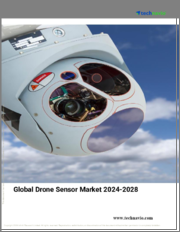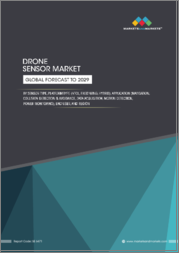
|
시장보고서
상품코드
1573715
드론 센서 시장 : 기회, 성장 촉진요인, 산업 동향 분석과 예측(2024-2032년)Drone Sensor Market, Opportunity, Growth Drivers, Industry Trend Analysis and Forecast, 2024-2032 |
||||||
세계의 드론 센서 시장 규모는 14억 달러로, 2024-2032년 CAGR은 15% 이상으로 성장할 것으로 예측됩니다.
농업, 건설, 부동산, 배송 서비스 등 상업 분야에서 드론의 채택이 증가하고 있는 것이 이러한 성장에 힘을 실어주고 있습니다. 정밀농업 분야에서는 첨단 센서가 장착된 드론이 작물의 건강 상태를 모니터링하고 토양 상태를 평가하며 자원 활용을 최적화합니다. 건설 분야에서는 드론이 현장 모니터링과 프로젝트 관리에 실시간 데이터를 제공하여 작업 효율성과 안전성을 향상시킵니다.
국방 및 군 분야는 드론 센서 시장을 크게 견인하고 있습니다. 드론은 감시, 정찰, 정보 수집에 필수적이며, 이러한 분야에서 첨단 센서에 대한 수요가 시장 성장을 촉진하고 있습니다. 군 작전에서 열, 야시경, 음향 센서가 장착된 드론에 대한 수요가 높으며, 정확하고 신뢰할 수 있는 데이터의 중요성이 강조되고 있습니다.
드론용 센서의 동향 중 주목할 만한 것은 센서의 소형화다. 이러한 진화를 통해 더 작고 가벼운 드론에 고급 및 다중 센서를 통합할 수 있게 되었습니다. 소형화를 통해 드론은 업종에 관계없이 다용도로 사용할 수 있으며, 무게와 전력 소비를 줄이면서 높은 성능을 보장할 수 있습니다. 이러한 진화는 드론이 넓은 지역을 정밀하게 커버해야 하는 농업이나 좁은 공간이나 위험한 공간에 접근해야 하는 산업 검사 등의 분야에서 매우 중요합니다.
장애물 감지 및 회피 분야는 예측 기간 중 18% 이상의 CAGR을 나타낼 것으로 예상됩니다. 이 분야는 드론이 실시간으로 장애물을 감지하고 회피할 수 있는 센서에 초점을 맞추었습니다. 이 분야에서 일반적으로 사용되는 센서에는 LiDAR, 초음파, 적외선 센서, 카메라 등이 있습니다. 이러한 툴은 3D 환경지도를 생성하여 충돌을 피할 수 있게 해줍니다. 드론이 혼잡한 장소(도시 지역, 산업 현장, 실내 환경)에서 더 많은 용도를 찾게 되면서 이러한 센서에 대한 수요가 급증할 것입니다. 화물 배송, 인프라 점검, 긴급 대응 등 항행의 정확성과 안전이 가장 중요한 상황에서 그 중요성은 더욱 커질 것입니다.
VTOL 분야는 2032년까지 15억 달러 이상의 매출을 창출할 것으로 예상되며, VTOL 분야는 헬리콥터처럼 수직 이륙, 호버링, 착륙이 가능한 드론을 중심으로 하고 있습니다. VTOL 드론은 도시 환경, 해상 작전, 수색 및 구조 임무 등 이착륙 공간이 제한된 시나리오에서 빛을 발하며, VTOL 드론의 주요 센서에는 첨단 자이로스코프, 가속도계, 기압계가 포함됩니다. 수직 조종시 안정성과 제어성을 보장합니다. 또한 이러한 드론은 종종 복잡한 환경에서 안전한 작동을 보장하기 위해 고급 내비게이션 및 장애물 감지 센서를 갖추고 있습니다.
2023년 북미는 전 세계 드론 센서 시장을 주도하며 35% 이상의 점유율을 차지할 것으로 예상됩니다. 이 지역의 우위는 국방, 농업, 물류와 같은 고부가가치 분야에서 드론이 광범위하게 채택되고 있기 때문입니다. 미국은 드론 센서 기술의 선두주자로서 강력한 정부 지원, 풍부한 R&D 투자, 강력한 산업 기반에 힘입어 드론 센서 기술의 선두 주자로 우뚝 섰습니다. 북미의 국방 분야가 시장을 주도하고 있으며, 첨단 센서가 장착된 드론은 감시, 첩보 및 전투 작전에서 중요한 역할을 하고 있습니다.
목차
제1장 조사 방법과 조사 범위
제2장 개요
제3장 업계 인사이트
- 에코시스템 분석
- 벤더 매트릭스
- 이익률 분석
- 테크놀러지와 혁신 전망
- 특허 분석
- 주요 뉴스와 구상
- 규제 상황
- 영향요인
- 촉진요인
- 상업 용도에서의 드론 수요 증가
- 군·방위 분야에서의 채택 확대
- AI 및 IoT와의 기술 통합
- 드론 기술에 대한 투자의 증가
- 센서 기술의 진보
- 업계의 잠재적 리스크 & 과제
- 첨단 센서의 고비용
- 배터리 수명과 페이로드 용량의 제한
- 촉진요인
- 성장 가능성 분석
- Porter의 산업 분석
- PESTEL 분석
제4장 경쟁 구도
- 서론
- 기업 점유율 분석
- 경쟁 포지셔닝 매트릭스
- 전략 전망 매트릭스
제5장 시장 추산·예측 : 센서 유형별, 2021-2032년
- 주요 동향
- 관성 센서
- 영상 센서
- 속도·거리센서
- 위치 센서
- 압력센서
- 광센서
- 전류 센서
- 초음파 센서
- 첨단 합계 센서
- 유량 센서
제6장 시장 추산·예측 : 플랫폼 유형별, 2021-2032년
- 주요 동향
- VTOL형
- 고정익
- 하이브리드
제7장 시장 추산·예측 : 용도별, 2021-2032년
- 주요 동향
- 내비게이션
- 장애물 탐지·회피
- 데이터 취득
- 모션 탐지
- 공기압 측정
- 전력 관리
- 기타
제8장 시장 추산·예측 : 최종 용도 산업별, 2021-2032년
- 주요 동향
- 건설
- 미디어·엔터테인먼트
- 정밀농업
- 에너지·유틸리티
- 군·방위
- 소비자
- 법집행기관
- 기타
제9장 시장 추산·예측 : 지역별, 2021-2032년
- 주요 동향
- 북미
- 미국
- 캐나다
- 유럽
- 영국
- 독일
- 프랑스
- 이탈리아
- 스페인
- 기타 유럽
- 아시아태평양
- 중국
- 인도
- 일본
- 한국
- 뉴질랜드
- 기타 아시아태평양
- 라틴아메리카
- 브라질
- 멕시코
- 기타 라틴아메리카
- 중동 및 아프리카
- UAE
- 남아프리카공화국
- 사우디아라비아
- 기타 중동 및 아프리카
제10장 기업 개요
- Aerotenna
- AgEagle Aerial Systems Inc.
- AMS-Osram Ag
- Bosch Sensortec GmbH
- HBK, Inc.
- Honeywell International Inc.
- InvenSense Inc.
- Leddartech Holdings Inc.
- Omnivision Technologies
- RTX
- Sensirion AG
- Sentera
- Skydio, Inc.
- Sony Semiconductor Manufacturing Corporation
- STMicroelectronics
- TE Connectivity
- Teledyne Flir Llc
- Trimble Inc.
- Velodyne Lidar, Inc.
- Yost Labs
The Global Drone Sensor Market was valued at USD 1.4 billion and is projected to grow at a CAGR of over 15% from 2024 to 2032. The rising adoption of drones in commercial sectors such as agriculture, construction, real estate, and delivery services drives this growth. In precision agriculture, drones with advanced sensors monitor crop health, evaluate soil conditions, and optimize resource usage. In construction, drones provide real-time data for site monitoring and project management, boosting operational efficiency and safety.
The defense and military sectors significantly propel the drone sensor market. Drones are essential for surveillance, reconnaissance, and intelligence gathering, with the demand for sophisticated sensors in these areas fueling market growth. Military operations show a high demand for drones with thermal, night vision, and acoustic sensors, underscoring the importance of accurate and reliable data.
A notable trend in the drone sensor landscape is the miniaturization of sensors. This evolution permits the integration of advanced and multiple sensors into smaller, lighter drones. Miniaturization enhances drone versatility across industries and ensures high performance with reduced weight and power consumption. This advancement is crucial in sectors like agriculture, where drones must cover vast areas with precision, and in industrial inspections, where accessing confined or hazardous spaces is necessary.
The overall drone sensor industry is classified based on sensor type, platform type, application, end-use, and region.
The obstacle detection and avoidance segment is anticipated to witness a CAGR exceeding 18% during the forecast period. This segment emphasizes sensors that enable drones to detect and navigate around obstacles in real-time, a vital feature for ensuring safety, especially in autonomous operations. Commonly utilized sensors in this domain include LiDAR, ultrasonic, infrared sensors, and cameras. These tools generate a 3D environmental map, enabling collision avoidance. As drones find more applications in congested locales-urban areas, industrial sites, or indoor settings-the demand for these sensors surges. Their importance is magnified in scenarios like package delivery, infrastructure inspection, and emergency response, where navigation precision and safety are paramount.
The VTOL segment is set to generate revenues exceeding USD 1.5 billion by 2032. The VTOL segment centers on drones capable of vertical take-off, hovering, and landing, akin to helicopters. These drones utilize specialized sensors to enhance their distinct flight abilities. VTOL drones shine in scenarios with constrained take-off and landing spaces, such as urban settings, maritime operations, and search-and-rescue missions. Key sensors in VTOL drones include advanced gyroscopes, accelerometers, and barometers, ensuring stability and control during vertical maneuvers. Furthermore, these drones often feature advanced navigation and obstacle detection sensors, guaranteeing safe operations in intricate environments.
In 2023, North America led the global drone sensor market, capturing over 35% of the share. The region's dominance stems from the extensive adoption of drones in high-value sectors like defense, agriculture, and logistics. The U.S. stands out as a frontrunner in drone sensor technology, bolstered by robust government backing, substantial R&D investments, and a strong industrial foundation. The North American defense sector significantly propels the market, with advanced sensor-equipped drones playing a crucial role in surveillance, intelligence, and combat operations.
Table of Contents
Chapter 1 Methodology and Scope
- 1.1 Market scope and definition
- 1.2 Base estimates and calculations
- 1.3 Forecast calculation
- 1.4 Data sources
- 1.4.1 Primary
- 1.4.2 Secondary
- 1.4.2.1 Paid sources
- 1.4.2.2 Public sources
Chapter 2 Executive Summary
- 2.1 Industry 360° synopsis, 2021-2032
Chapter 3 Industry Insights
- 3.1 Industry ecosystem analysis
- 3.2 Vendor matrix
- 3.3 Profit margin analysis
- 3.4 Technology and innovation landscape
- 3.5 Patent analysis
- 3.6 Key news and initiatives
- 3.7 Regulatory landscape
- 3.8 Impact forces
- 3.8.1 Growth drivers
- 3.8.1.1 Growing demand for drones in commercial applications
- 3.8.1.2 Increased adoption in military and defense
- 3.8.1.3 Technological integration with AI and IoT
- 3.8.1.4 Increasing investment in drone technology
- 3.8.1.5 Advancements in sensor technology
- 3.8.2 Industry pitfalls and challenges
- 3.8.2.1 High cost of advanced sensors
- 3.8.2.2 Limited battery life and payload capacity
- 3.8.1 Growth drivers
- 3.9 Growth potential analysis
- 3.10 Porter's analysis
- 3.10.1 Supplier power
- 3.10.2 Buyer power
- 3.10.3 Threat of new entrants
- 3.10.4 Threat of substitutes
- 3.10.5 Industry rivalry
- 3.11 PESTEL analysis
Chapter 4 Competitive Landscape, 2023
- 4.1 Introduction
- 4.2 Company market share analysis
- 4.3 Competitive positioning matrix
- 4.4 Strategic outlook matrix
Chapter 5 Market Estimates and Forecast, By Sensor Type, 2021-2032 (USD Million and Units)
- 5.1 Key trends
- 5.2 Inertial sensor
- 5.3 Image sensor
- 5.4 Speed and distance sensor
- 5.5 Position sensor
- 5.6 Pressure sensor
- 5.7 Light sensor
- 5.8 Current sensor
- 5.9 Ultrasonic sensor
- 5.10 Altimeter sensor
- 5.11 Flow sensor
Chapter 6 Market Estimates and Forecast, By Platform Type, 2021-2032 (USD Million and Units)
- 6.1 Key trends
- 6.2 VTOL
- 6.3 Fixed wing
- 6.4 Hybrid
Chapter 7 Market Estimates and Forecast, By Application, 2021-2032 (USD Million and Units)
- 7.1 Key trends
- 7.2 Navigation
- 7.3 Obstacle detection and avoidance
- 7.4 Data acquisition
- 7.5 Motion detection
- 7.6 Air pressure measurement
- 7.7 Power management
- 7.8 Others
Chapter 8 Market Estimates and Forecast, By End-use Industry, 2021-2032 (USD Million and Units)
- 8.1 Key trends
- 8.2 Construction
- 8.3 Media and entertainment
- 8.4 Precision agriculture
- 8.5 Energy and utilities
- 8.6 Military and defense
- 8.7 Consumer
- 8.8 Law enforcement
- 8.9 Others
Chapter 9 Market Estimates and Forecast, By Region, 2021-2032 (USD Million and Units)
- 9.1 Key trends
- 9.2 North America
- 9.2.1 U.S.
- 9.2.2 Canada
- 9.3 Europe
- 9.3.1 UK
- 9.3.2 Germany
- 9.3.3 France
- 9.3.4 Italy
- 9.3.5 Spain
- 9.3.6 Rest of Europe
- 9.4 Asia Pacific
- 9.4.1 China
- 9.4.2 India
- 9.4.3 Japan
- 9.4.4 South Korea
- 9.4.5 ANZ
- 9.4.6 Rest of Asia Pacific
- 9.5 Latin America
- 9.5.1 Brazil
- 9.5.2 Mexico
- 9.5.3 Rest of Latin America
- 9.6 MEA
- 9.6.1 UAE
- 9.6.2 South Africa
- 9.6.3 Saudi Arabia
- 9.6.4 Rest of MEA
Chapter 10 Company Profiles
- 10.1 Aerotenna
- 10.2 AgEagle Aerial Systems Inc.
- 10.3 AMS-Osram Ag
- 10.4 Bosch Sensortec GmbH
- 10.5 HBK, Inc.
- 10.6 Honeywell International Inc.
- 10.7 InvenSense Inc.
- 10.8 Leddartech Holdings Inc.
- 10.9 Omnivision Technologies
- 10.10 RTX
- 10.11 Sensirion AG
- 10.12 Sentera
- 10.13 Skydio, Inc.
- 10.14 Sony Semiconductor Manufacturing Corporation
- 10.15 STMicroelectronics
- 10.16 TE Connectivity
- 10.17 Teledyne Flir Llc
- 10.18 Trimble Inc.
- 10.19 Velodyne Lidar, Inc.
- 10.20 Yost Labs

















